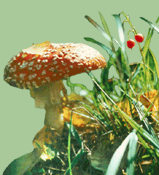Estonian weather is cruel and cunning
Ain Kallis introduces weather phenomena, which may prove dangerous: tornados, thunderstorms, floods and some less dangerous occurrences. Heavy and destroying storms are not common in Estonia: a real storm happens about once in a century (most recently in January 2005). The most harm is done by floods and heavy storms, while thunderstorms usually bring about smaller destructions. Tornados are quite rare, as well as extremely cold or extremely hot temperature. The numerous tables appended to the cover story illustrate the weather phenomena and their effects also in numbers.
Invertebrate danger
Marti Martin takes a brief look at the large amount of invertebrates, which may endanger us as parasites. Luckily for us, most of these dangerous parasites prefer warmer climate. The detailed photos about diseases and health impairments brought about these parasites are very illustrative, supported by short overview of each of the parasite and its way of life. However, there are dangerous parasites in Estonia as well, such as Trichinella spiralis, a nematode parasite and Echinococcus granulosus, a cyclophyllid cestode as well as the itch mite (Sarcoptes scabiei), a parasitic arthropod which burrows into skin and causes scabies.
How dangerous are the large carnivores of our forests?
Peep Männil intends to make clear if it is reasonable to go to forest when afraid of wolves. Normally, large carnivores do not attack people. There are exceptions, however; for example, when an animal has rabies or scabies or when it intends to protect its offspring.
Ticks, our everyday enemies
Mati Martin describes the way of life of ticks and the chances for humans to meet ticks in nature. In Estonia, 4−5 species of ticks have been identified, the most common of these being Ixodes persulcatus tick, or the taiga tick, and Ixodes ricinus, known as the sheep tick or castor bean tick. These are all hard-bodied ticks. The tick season usually starts in April and lasts till October.
Tick-borne infections in Estonia
Tiina Prükk gives an overview of diseases spread by ticks. The most dangerous among these is tickborne viral encephalitis. A wide-spread and well-known tickborne infection is the Lyme disease. Ticks may also be vectors for some other, less-spread diseases, such as Ehrlichiosis, Tularemia and Babesiosis.
Ticks as carriers of tick-borne viral encephalitis
Veera Vassilenko observes the regional spread of tick-borne viral encephalitis in Estonia. Any infectious disease that can be transmitted (in some instances, by a vector) from non-human animals, both wild and domestic, to humans or from humans to non-human animal is called a zoonosis or zoonose. One tick can be a carrier of many tickborne diseases simultaneously. The most dangerous among zoonosis of Estonia is viral encephalitis.
Estonian Nature enquires
Mare Liiger summarizes the dangers brought about Estonian nature as seen by a paramedic.
Marika Mann writes about how economic recession influences bird-watching tourism.
Poisonous mushrooms and mushroom poisoning in Estonia
Irja Saar warns against most poisonous mushrooms, which may lead to death or health impairment when eaten. In Estonia there are about 200 species of mushrooms which are more or less poisonous. About 15 of these can give lethal reactions for humans when eaten. The most dangerous species are Amanita species death cap and European destroying angel.
Attention: many spring flowers are poisonous
Ülle Reier introduces a number of well-known spring flowers from a new point of view: even tulips and daffodils can cause intoxication to most vulnerable people. The author describes about three dozen of spring plants or spring flowers that can be poisonous. The most toxic among these are Cowbane or Northern Water Hemlock and Daphne mezereum.
Why does bog seem as such a dangerous and horrible place?
Ann Marvet disproves the myth of bogs as dangerous places: one needs to know certain things and remain sober. Bog pools mostly have firm shores, but bog hollows can be much trickier. When one has to cross hollows, its important to maintain a light and fast pace.
Getting lost
Aivar Jürgenson recalls the folk beliefs about getting lost in the forest: forest has been a strange place, rather than a homelike place. The most common folk figure responsible for getting lost is a forest elf. Sometimes people get lost in certain places in landscape. Beliefs about getting lost have been and still are more common in South-Estonia, especially in Setumaa.
Fear has wide eyes
Marju Kõivupuu takes a look into the garner of folk tales and finds our ancestors fears for the known and unknown. Based on folk myths, she points out several sources of fear, such as different (mythological) creatures, but also the fear of punishment and of cursed places. The many folk texts from archives well illustrate the folk myths of Estonians in previous days.
Interview: Stomatal responses help the plants to cope with stress
Toomas Kukk has interviewed Hannes Kollist, a plant physiologist.
Hiking trail: Across Estonia on skies
Indrek Hiiesalu shares his impressions on the seemingly awful event: the members of the Tartu Student Nature Protection Circle hiked from the southernmost point of Estonia to the northernmost point of Estonia. On skies. As this winter showed mostly really cold temperatures, the students even skied in 30 degrees. The appended map illustrates their rout choice and the daily distances.
Horsecart roads
Aimur Joandi reminds us of eternally lost elements of our landscapes. Horsecart roads have been washed off by melioration or by modern development. However, there are a few sections of horscart roads still left in Estonia, for example in the Soomaa region.
|


![[IN ENGLISH]](images/gb.gif)





